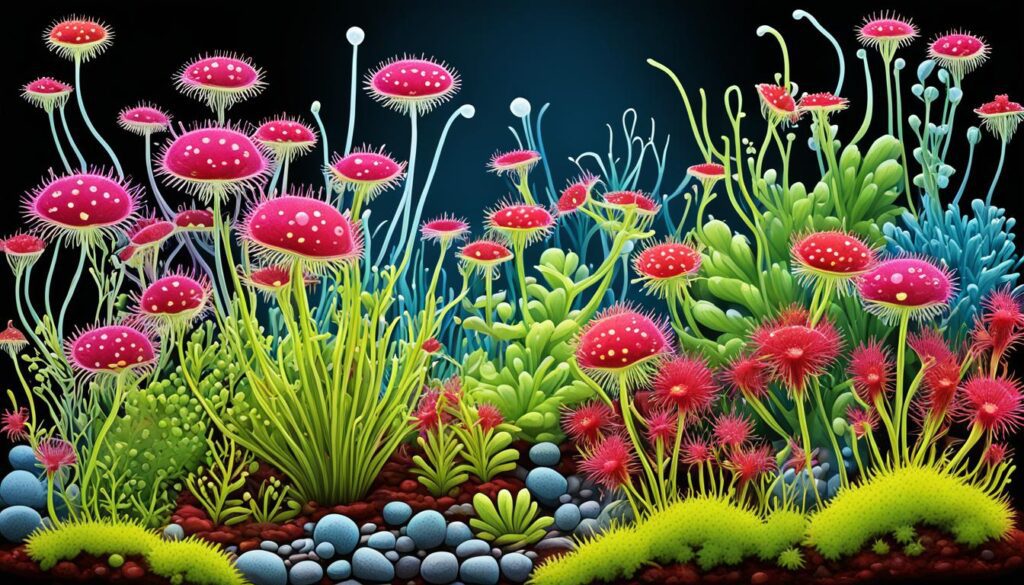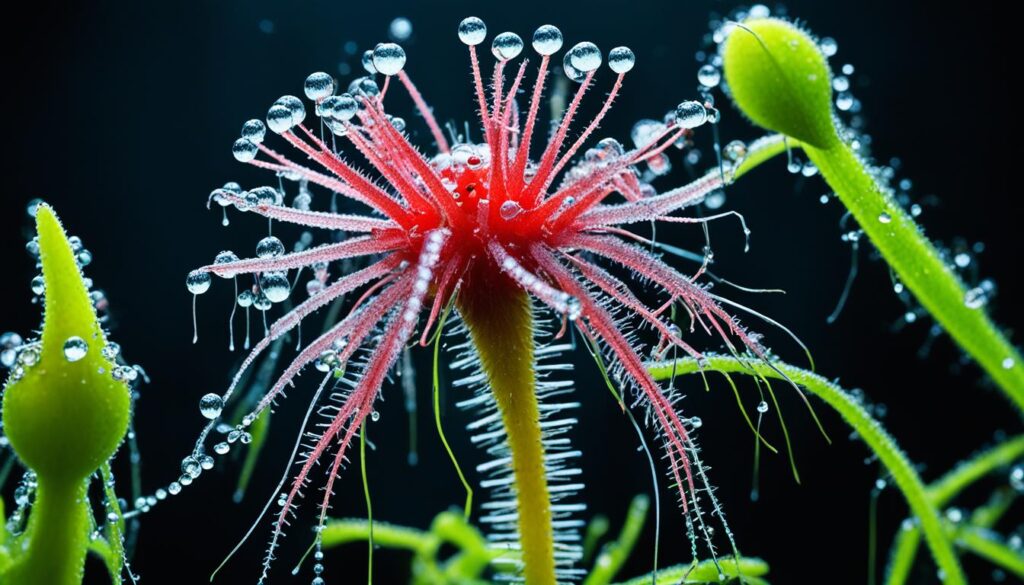The captivating genus of Drosera, commonly known as sundews, has long been the subject of fascination among plant enthusiasts and naturalists alike. These botanical marvels, part of the Droseraceae family, are renowned for their unique adaptations that allow them to prey upon and digest small insects. From the lush, tropical regions to the temperate zones, sundews can be found thriving in diverse habitats, showcasing their exotic appearances and remarkable predatory behaviors.
Sundews have captured the hearts of gardeners and botanists alike, who are drawn to their intriguing and often mesmerizing characteristics. These carnivorous plants, which include a variety of species such as pitcher plants and Venus flytraps, have evolved remarkable strategies to attract, capture, and consume their prey, making them a truly captivating addition to any plant collection or botanical garden.
Unveiling the Enchanting World of Drosera
The Drosera genus, commonly known as sundews, is a captivating group of carnivorous plants that have long enchanted both botanists and nature enthusiasts alike. These remarkable flora are renowned for their intricate adaptations that allow them to thrive as efficient predators, blending form and function in a truly captivating display.
The Botanical Marvel of Sundews
At the heart of the sundew’s allure lies its unique morphology. Drosera plants are characterized by their leaves covered in glandular tentacles that secrete a sticky, dew-like substance. This sticky secretion serves to attract and trap small insects, which the plant then proceeds to digest, supplementing its nutrient intake. The diverse Drosera species exhibit a wide range of shapes, sizes, and colors, from delicate, miniature forms to larger, more robust varieties, each showcasing the plant’s remarkable adaptations.
Exploring the Diverse Drosera Species
The Drosera genus encompasses a vast array of species, each with its own unique characteristics and adaptations. From the diminutive Drosera pygmaea, measuring just a few centimeters in diameter, to the larger, more robust Drosera capensis, the diversity of sundews is truly remarkable. These plants can be found in a range of habitats, from tropical rainforests to temperate bogs and wetlands, with many species endemic to specific regions.
Unfortunately, some Drosera species, such as the rare Drosera regia, are considered endangered due to habitat loss and overexploitation. This underscores the importance of conservation efforts to protect these botanical wonders, ensuring that their enchanting presence continues to captivate hearts and minds for generations to come.

“The botanical marvel of sundews lies in their intricate adaptations that have evolved to make them efficient carnivorous predators, blending form and function in a truly impressive display.”
The Drosera: Nature’s Remarkable Insect Predator
Drosera plants, commonly known as sundews, are remarkable insect predators that have evolved unique adaptations to thrive in nutrient-poor environments. These carnivorous plants employ a sticky, dew-like substance secreted by their glandular tentacles to lure, capture, and digest their prey.
The Sticky Snare: How Drosera Captures Its Prey
The key to Drosera’s prey capture mechanism lies in the specialized glandular tentacles that cover the surface of its leaves. These tentacles secrete a viscous, sticky substance that glistens like dew, attracting unsuspecting insects such as flies, mosquitoes, and even small spiders. When an insect lands on the leaf, the tentacles quickly ensnare it, trapping the prey in a sticky web.
Once the insect is captured, the plant’s digestive enzymes begin to break down the prey, allowing the Drosera to absorb the essential nutrients it needs. This remarkable predatory behavior is a testament to the evolutionary adaptations that have enabled these carnivorous plants to flourish in environments where resources are scarce.

The Drosera’s glandular tentacles play a crucial role in its prey capture mechanism, secreting a sticky substance that lures and traps its unsuspecting victims. As the plant’s digestive enzymes break down the prey, the Drosera is able to absorb the nutrients it needs to thrive in its nutrient-poor environment.
“The Drosera’s remarkable predatory behavior is a testament to the evolutionary adaptations that have enabled these carnivorous plants to flourish in environments where resources are scarce.”
Cultivating and Caring for Drosera
Growing and caring for Drosera plants, also known as sundews, can be a captivating and rewarding hobby for both novice and experienced gardeners. These carnivorous plants require specific growing conditions to thrive, making them a unique and fascinating addition to any plant collection.
Creating the Perfect Habitat for Your Carnivorous Companion
The key to successful Drosera cultivation lies in replicating their natural habitat. These plants prefer a well-draining, nutrient-poor soil mix that is high in organic matter. A mixture of sphagnum moss, perlite, and sand or fine gravel can provide the ideal substrate for Drosera to flourish.
Lighting is another crucial factor in Drosera cultivation. These plants thrive in bright, direct sunlight, so they should be placed in a location that receives ample natural light, such as a sunny windowsill or a dedicated greenhouse. Supplemental lighting may be necessary in areas with limited natural light.
Maintaining high humidity is essential for Drosera. These plants hail from wetland and bog environments, so they require a moist, humid atmosphere to reach their full potential. A closed terrarium or greenhouse can help create the ideal microclimate, with humidity levels ranging from 60% to 100%.
Watering is a delicate balance for Drosera. They require consistently moist, but not waterlogged, soil. During the growing season, the soil should be kept constantly damp, while during the dormant winter months, the soil can be allowed to dry out slightly between waterings.
| Drosera Cultivation Requirement | Optimal Conditions |
|---|---|
| Soil Mix | Well-draining, nutrient-poor, high in organic matter (sphagnum moss, perlite, sand/gravel) |
| Lighting | Bright, direct sunlight (supplemental lighting may be needed) |
| Humidity | 60% to 100% (achieved through closed terrariums or greenhouses) |
| Water Needs | Consistently moist, but not waterlogged, soil |
By providing Drosera with the right soil, lighting, humidity, and water, gardeners can create a thriving, captivating environment for these carnivorous plants to flourish. With the proper care and attention, Drosera can make a stunning and unique addition to any plant enthusiast’s collection.
Conclusion
The captivating Drosera, or sundews, are truly botanical wonders that continue to enchant plant enthusiasts, gardeners, and nature lovers worldwide. These carnivorous plants, with their diverse range of species and remarkable adaptations, offer a unique and fascinating glimpse into the natural world.
From their sticky traps that effortlessly ensnare unsuspecting insects to their stunning displays of vibrant colors and intricate structures, Drosera plants have the power to captivate all who encounter them. By cultivating and caring for these remarkable carnivores, we not only appreciate their beauty but also contribute to the conservation of these botanical marvels.
As we delve deeper into the world of Drosera, we uncover a wealth of ecological significance and scientific wonder. These plants serve as important indicators of environmental health and play a crucial role in their native ecosystems. By nurturing and protecting Drosera, we safeguard the delicate balance of our natural world, ensuring that these enchanting carnivorous plants continue to thrive for generations to come.
FAQ
What are Drosera plants?
Drosera, commonly known as sundews, are a genus of carnivorous plants that belong to the Droseraceae family. They are known for their unique adaptations that allow them to capture and digest small insects.
What are the key characteristics of Drosera plants?
Drosera plants are characterized by their leaves covered in glandular tentacles that secrete a sticky, dew-like substance to attract and trap small insects. They exhibit a wide range of shapes, sizes, and colors, from delicate, miniature forms to larger, more robust varieties.
How diverse is the Drosera genus?
The Drosera genus encompasses a wide variety of species, each with its own unique characteristics and adaptations. These plants can be found in a range of habitats, from tropical rainforests to temperate bogs and wetlands, with many species endemic to specific regions.
How do Drosera plants capture and digest their prey?
Drosera plants use their unique adaptations to lure, capture, and digest small insects. The sticky, dew-like substance secreted by the glandular tentacles on the leaves serves to attract and trap the prey, and the plant’s digestive enzymes then break down the insect, allowing the Drosera to absorb the nutrients it needs.
What are the requirements for growing and caring for Drosera plants?
Drosera plants require specific growing conditions to thrive, including a well-draining, nutrient-poor soil mix, high humidity, and ample sunlight. Providing the right balance of water, light, and humidity is crucial for the long-term health and vigorous growth of these captivating carnivorous plants.